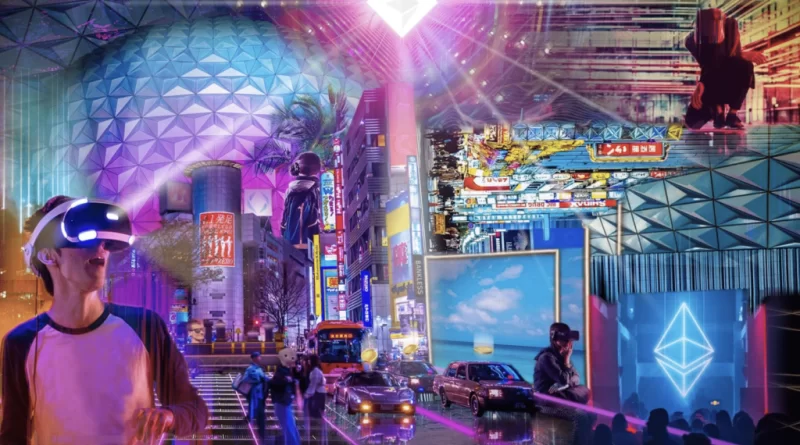How AR and VR Technologies Are Revolutionizing Metaverse?
The metaverse concept is strongly linked to technologies such as artificial intelligence (AI), augmented reality (AR), and virtual reality (VR). Augmented reality technology enables the incorporation of virtual items into the physical world. VR entails immersing yourself in a 3D virtual environment by using 3D computer modeling, one of the most exciting styles of graphic design. While wearing a VR headset or other attachments isn’t required in the metaverse, experts are sure that virtual reality technology will become an essential component of the new environment.
The Facebook metaverse, for example, is likely to be accessible via virtual reality headsets, smart glasses with augmented reality, and in limited ways via desktop and mobile applications. The company has already disclosed that it is working on a premium virtual and augmented reality headgear codenamed “Project Cambria.” According to Meta, the device will support mixed reality and will incorporate new sensors that will allow the virtual avatar to maintain eye contact and mimic human facial emotions. Avatars will be able to use body language and better depict human emotions as technology advances, creating the illusion of real dialogue in virtual space.
According to Statista, the combined AR/VR market is estimated to be worth almost $300 billion by 2024, and $100 billion by 2030, as predicted by Morgan Stanley.
Virtual Reality and Metaverse
Customers can enter the metaverse through virtual reality, closing the apparent divide between digital and physical realities. Virtual versions of people, things, and landscapes will allow us to explore new worlds and make information more accessible to everyone. In a nutshell, it is a virtual reality world where you may go to school, work, play games, watch concerts, browse store shelves, and do a variety of other things without leaving your (physical) house.
People can go to events, do shopping, and learn about the possibilities of virtual reality. Alternatively, augmented and mixed reality will enable us to enhance our physical world in ways never before possible. Even XR add-ons, such as haptic comment tools, will allow us to bridge relationship distances and sense our contacts’ handshakes and hugs no matter where they are.
The Virtual Fixtures system allowed users to engage with digital devices that were properly integrated into their perception of an actual environment. This was discovered before phrases like “augmented reality” or “blended reality” was developed. The virtual reality experience is really unpleasant. Not because of the low fidelity, this may improve over time, but because it felt constraining and claustrophobic to have a dive mask strapped to my face for an extended period of time.
Augmented Reality in Metaverse
According to Mark Zuckerberg, one of the industry leaders currently investing in the metaverse concept, a metaverse is a form of “embodied internet.” It’s something you could dive into (through VR) or bring to life (via AR). Virtual worlds are becoming increasingly popular, but the genuine metaverse may be the future of augmented reality, and it will be everywhere. This is why, while widely used, the metaverse could be augmented reality environments accessed via see-through lenses. This will be true even though comprehensive virtual reality technology will deliver significantly better consistency. The reality is that visual fidelity isn’t always the factor that determines widespread acceptance.
Instead, adoption might be driven by determining which technology provides the most natural delight in our perceptual system. And the most natural way to offer virtual content to the human perceptual system is to integrate it immediately into our physical environment. Sensory cues such as sight, hearing, touch, and motion flow into a single mental representation of the arena within your brain. With augmented reality, this may be accomplished with relatively low visual constancy as long as virtual factors are spatially and temporally detected in your surroundings in a compelling manner. And, of course, because our sense of distance (i.e. intensity perception) is so strong, this is no longer difficult to believe.
The earth will be inherited by augmented reality. It will not only replace virtual reality as our major portal to the metaverse, but it may even replace the modern environment of phones and computers as our primary interface to digital content material. Augmented reality may even give us superpowers, allowing anyone to change our world with the flick of a finger or the blink of an eye.
Conclusion
According to computer aficionados, the metaverse might usher in a new stage in the evolution of the Internet, dissolving barriers and immersing us completely in the digital world. Because VR/AR technologies play an important part in the construction of metaverses, the industry is expected to rise rapidly in the future years. If the metaverse is a virtual space, then VR is a means of accessing it.
However, VR capabilities are often limited by current gear, which is costly and inconvenient for long-term use. In terms of augmented reality, current smartphones have made it available to billions of people, making it a go-to technology for large-scale metaverse development.
We still have many doubts about how the metaverse will work, how big the benefits it will give, and how accessible it will be to average users. However, if properly implemented, the metaverse has the potential to increase online engagement for people all around the world.




